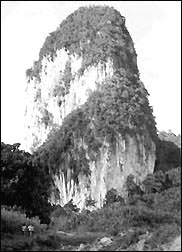
Climbing Up the Tiger's Tooth
by Yap Peng Lee
The Seladang 1965

|
Suddenly I was slipping down the wet limestone rock. My leg moved over for a toehold that was not there. It was like a nightmare where everything happens in slow motion. Below me, the sheer vertical face ended in a rocky bottom. Then suddenly, my friend had caught my wrists and swung me up on to a crack in the rock about two inches wide. I then scrambled onto a ledge which led to a smooth sided vertical tube leading upwards. 
The route to its base is a long and tortuous walk through undergrowth. Around it is much abandoned mining land so that you go up and down with the creepers dragging at your feet. From the distance, the mountain looks near but after much walking, it seems as unreachable as a mirage. Suddenly you burst upon an open area and there reaching straight upwards is Bukit Takun. As you near it, there seems to be a silence that is slightly eerie. There is the high pitched hum of the cicadas. You walk in the dark undergrowth. Small boulders give way as you step on them. The firm laterite gives way to slippery mud. After a hard climb, during which you fight for breath, you come to a cleft in the limestone reaching to great depths. It was in here that our Scoutmaster fell some years ago, while exploring, and had to be lifted out. Somewhere nearby you can hear a small stream cascading over the rocks but search, and you will not find it. You move along in the shade cast by the giant mass of rock. You come to the base and even now your feet ache with pain. The perpendicular face is criss-crossed with cracks. By edging along the cracks, you can rise inch by inch until you reach a chimney-like structure. The sides have been worn down to smoothness and it is only by pushing up with the feet and the back that can you climb it. After this, the ascent consists of crawling over a series of parallel limestone ridges. The tops of the rocks are pitted with tiny holes so that each surface is like a porcupine with needle-sharp slivers of rock. As you grip the rocks your palms become more and more painful until you no longer feel the pain. They become red with innumerable pin pricks. The sides of the rock are covered with all sorts of vegetation - brittle plants that snap when they are stepped upon, leaves that are lined with needle-sharp barbs, moss that is springy underfoot. In fact, the mountain itself is a botanist's wonderland with species of plants not found elsewhere. The sheer naked beauty of Nature strikes you as you climb higher and higher. The feeling of exhilaration comes when you gaze upon the land below and feel the wind striking your face. Up here, the wind blows and whistles. Below are thin greyish lines reaching among the canopy of green. But this cannot be admired until the top is reached. Every step is fraught with danger. Some rocks rumble when you step upon them; other's fall down tumbling. You no longer have control of yourself: you go on and on until climbing becomes almost automatic and mechanical. Yet you cannot stop, because the summit is so tantalizing and because "it is there". All sorts of obstacles lie in your path. You must push yourself up a 15-foot high chimney of rock. You must leap across a gap of rocks. You must trust the direction of the leader because danger lies everywhere. Finally, you cannot believe it, but yes, at last you have reached the top. The blistering heat, the aching limbs, the throbbing pain were all worth it. As you stand high up and look below and feel immortal you come to understand why the Greek Gods chose Mt. Olympus. But you cannot linger too long. Already nearly two hours have been spent climbing. You carefully return by the same path you came on. When the mountain was first climbed by scouts, they came down the wrong way and were lost in the jungle below. They wandered in the night and licked the dew off the leaves to ease their thirst. By a stroke of luck, they reached the main road at 1 a.m. in the night. But this does not happen to you. You descend even more carefully than you ascended. Every action becomes mechanical once again. Each step becomes an agony. You stop but your knees have turned to rubber and cannot stay still. Your hand quivers and no longer possesses any strength. After an eternity, you reach the base and from there stumble to the kongsi two miles away. As you sit down and sip a cup of scalding tea, you are struck by a feeling of satisfaction which comes every time no matter how many times you have climbed up. It is the feeling of having achieved something. The feeling of having climbed Bukit Takun. The climb described took place in September 1964. Recently, in December last year, the writer made another ascent with four other scouts. This ascent was the seventh achieved by the First K.L. Scouts in recent years. A point of interest is that one of the first persons to discover the route up was Phua Juay Chee, the 1964 School Captain. The Assistant Scout Master for the Boy Scouts, Au-Yong Kun Ying, has climbed up eight times in all. Chong Sze Foh, Assistant Senior Scout Master, has reached the summit seven times.  The V.I. Web Page
The V.I. Web PageLast update on 24 November 2003. Pagekeeper: Chung Chee Min |